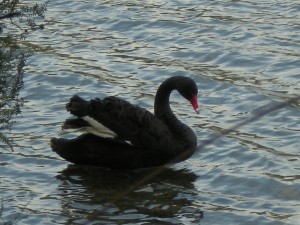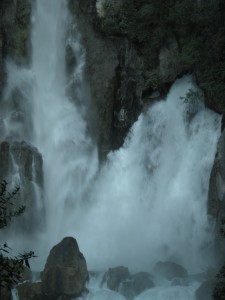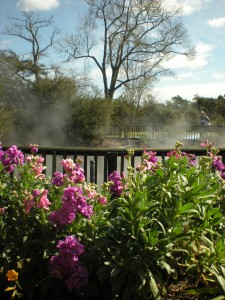What do you call thousands of gallons of water materializing out of nowhere? Tarawera Falls! The highlight of our central North Island explorations has been thousands of years in the making. New Zealand is a very volcanic nation where two major tectonic plates collide and fault lines shred the country. Over the ages, eruptions from nearby Mt. Tarawera have laid down layers of sometimes hollow volcanic material. Stunning, clear waters flow from the eponymous lake until they meet the aforementioned chambers. It’s quite a sight to see the entire river disappear right beneath your feet! Even more impressive is seeing the same waters a quarter mile later come bursting out of a soaring cliff face!
Our arrival at the falls was unintentional and preceded by various escapades, including helping a group of woman push-start their Toyota Hiace van, being disgusted by the librarians in Opotiki, meeting Sergio the Argentinian rugby fan in all his matè-and-Italian-liqueur glory, exploring the riverside trails of Whakatane (fuh-kuh-tah-nay), quality time at the library, chatting over Guinesses, and enjoying cheap-seats night at Cinema 5 seeing “The Change Up!” (A movie whose humor I expected to be of the immature-but-still-funny type found in “The Hangover” and “Super Troopers.” Smart, hilarious and totally recommended!)

Black swan, whose red bill I originally mistook for garbage while it fed in the shadows of shoreline vegetation.
We’d planned to beeline our way to the Yellowstone of New Zealand — Rotorua. After mentioning our love of craft products to the Whakatane tourism office, a detour to the craft brewery in small Kawerau became necessary. The smoldering, eggy sulpher vents in the middle of town made the sauerkraut smell of the paper-mill tolerable while lending the village some of the geo-thermal mystique its neighbors enjoy. After summiting the in-town overlook and uploading trip updates at the library, we made it to Mata Brewery. Their Manuka Honey Ale topped my favorites list, with the Black Bru and Brown Ale coming close seconds. Needless to say, we left a few riggers/flagons richer!
Various tourism signs around town had piqued our previously non-existent interest regarding Tarawera Falls. With encouragement from the brewery, we purchased a $5 permit that would allow us to use the logging roads necessary for a falls adventure. We bumped our way through soft volcanic soils, were appropriately impressed by the falls, got the Tarawera Lake Campground all to ourselves, slept in, and woke up to glorious sunshine! The crystal clear waters, quiet forest, and huge trout inspired a 7k fun-run down to the amazing falls and back. I got to see my first Wallabies bounding through the central-Oregon-esque scrub! Then I was generously rewarded for ignoring the fresh, yellow, do-not-enter tape on a side loop trail. Knowing the tape probably had something to do with super high water levels, washed out bridges, or fallen debris, I
picked my way carefully (and safely!) down the trail. The culprit was indeed a river in danger of breaching its banks, but the bridges were still just out of reach. It was such a rush to stand on a rail-less bridge and stare twenty feet to the bottom of a crystal clear pool as the water, two inches beneath my soles, slipped quickly by.
Once we’d enjoyed breakfast and relaxed ourselves to death, we set out for our original goal — Rotorua. If you’ve been to Yellowstone, imagine it full of houses, grocery stores, gas stations, shops, freeways, and restaurants and you’ve got Rotorua. Oh, and imagine that almost every major thermal feature has been made into its own attraction, with its very own price tag. Given that I was born in the state that is home to Yellowstone National Park AND worked there for an entire summer AND lived in the thermally active state of Oregon for four years AND have been to geothermal hot spots in South America… Rotorua didn’t exactly steal my heart. The privilege of seeing a shocking array of hot pools, mud pots, geysers, mineral terraces and more in Yellowstone will cost you $20 for 7 days. To see one or two of these things in Rotorua for 70
minutes runs anywhere from $20-$50. And they don’t have wolves, moose, grizzly bears, elk, black bears, or bald eagles in Rotorua. I’m not trying to be a Negative Nelly, but it feels like being asked to pay $100 for a bottle of Arbor Mist. And of course the wisdom of the ages -the old saying about “The more I travel, the more I appreciate home” – probably comes into play a bit here.
We settled for a self-tour around the big town park where vents spew hot blasts of air, mud pots burble, and alkaline pools glitter and steam behind wooden, split-rail fences. Then we followed a country road to a blueberry farm where we tested their juice, blueberry wine, fruit liqueurs, and berry* jams, jellies, and chutney. After indulging in blueberry, whipped-cream, ice-cream pancakes, we picked out a bottle of feijoa** liqueur to celebrate daylight savings on Sunday. Afterwards, we made our way to a giant, experimental forest block that was established when New Zealand was just a baby to determine what species would best support a strong forestry industry. Radiata Pine won out, but the California Redwoods got first place for majesty. They are now the hub of a network of trails that extend for miles through the block. And a perfect spot for dinner!
In the morning, we made our way up to Okere Falls where the trail snugs right up to the falls via steps cut into the cliffs a century ago. When we got back to town, we finally faced up to the fact that we’ve come to a country known for its adventure activities and not done a single one. The price tag on skydives, canyon swings, jetboat rides, and bungy jumps have just been too much to stomach given that going home gives us an automatic 70% off coupon. A $200 bungy jump? Am I buying the cord or just using it for 50 seconds? Much like the Yellowstone/Rotorua parallel above, this is another thing that falls in the “Thanks, but we’ll just do that at home” category. Imagine our surprise when we found out Skyline Adventure offered a luge and swing package for $60! We had SO much fun. It was awesome. The scenic luge had lots of pull-outs, photograph opportunities, funny sculptures, and even
cute little luge parking in their young stand of redwoods. The intermediate luge offered more intense turns, steeper inclines, and split trails perfect for racing to the bottom. The advanced track was the black diamond test of driving skill, apexing turns, flying around corners, and catching air on big drops. AWESOME! We ended our visit with the adrenaline rush of the cliff side swing.
The last and only time I was hoisted up and backward — sling shot style — by a giant machine was probably 12 years ago. It was probably at a carnival or state fair, and the swing was maybe as tall as a two story house. Comparatively, Skyline Rides Swing was a behemoth. We were strapped into harness by thick belts that came over our shoulders and between our legs. Then, for good measure, they clicked us into seat belts. Then our pod,
poised on the edge of a cliff, was slowly hoisted and drawn backward simultaneously. Almost instantly, our bodies started to tug against the harnesses as gravity tried to pull us back where we belonged. After about fifteen seconds, we were definitely dangling from the harnesses as we watched the ground get farther and farther away. We shared short bursts of adrenaline fueled conversation that centered around a feeling on impending death as details of the place we’d started began to disappear. Suddenly, the pod jerked to a stop illiciting shrieks from both of us. It’s at this point that at least one pod occupant must reach over, ignoring the ground more than a hundred feet below and the view over the town and lake that stretches for miles and miles AND PULL YOUR OWN RELEASE CORD! After I snapped a photo, I told Pat, “Okay, you do it.” He counted the fastest “Onetwothree” I’ve ever heard and yanked. The boom-snap of the release had nothing against our screams as we plummeted toward the earth, zoomed withing inches of the starting pad, and sailed out into the great beyond. Like a pendulum, we swung back and forth, breathing fast “That was incredibly awesome!”s and giggling (me) to each other, until the ride attendant had us back to square one. FnA!
After a visit to the local aquatic center for a swim workout and blessed I-live-in-a-van shower, we hit the grocery store and headed for Taupo! ♣
Adventure shots, springtime beauty, and mudpot burbles are also part of this photo album.
*Feijoa is heaven. One of my new favorite fruits that I’ve been introduced to here in NZ. Passionfruit gets the top spot, followed by feijoas and tamarillos. Feijoa is slightly grainy like a pear, but sweet and tart at the same time. Passionfruit is indescribable, melt-in-your-mouth sunshine.
**gooseberries in NZ aren’t like our gooseberies. Every time a wine snob told me a Sauvignon Blanc had a hint of “Guuuuzeberry,” you can imagine what I thought. Come to find out, NZ gooseberries are green, about the size of grape, and super
tart even when ripe. Wikipedia says they are loosely related to what we call gooseberries in the U.S.













Twitter Facebook Google+ StumbleUpon Reddit Pinterest